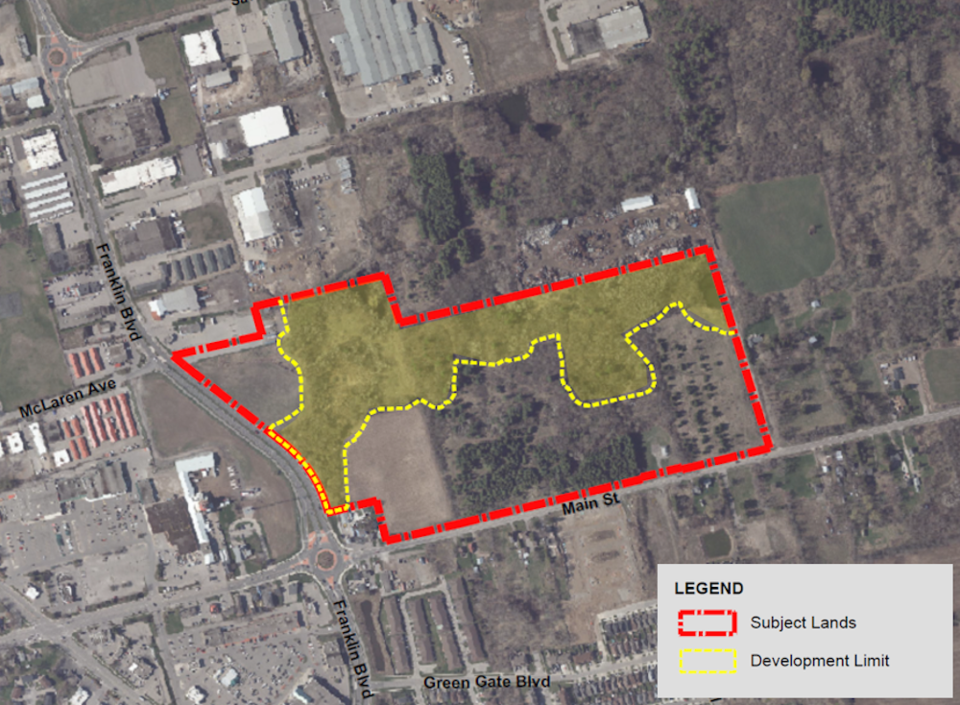A Cambridge development proposal has undergone intensive environmental studies to protect a regionally significant and potentially endangered species of salamanders.
The Taylor Lands development proposed by Reid's Heritage Homes at the corner of Main Street East and Franklin Boulevard in Cambridge could see 829 townhouses and apartments built on 14.2 hectares of land in the city's south end.
But a discovery of a population of regionally significant salamanders required a full environmental impact study (EIS) to be completed.
At first, it was believed that the rare and Jefferson salamander was discovered, but upon testing revealed that it was two different species of blue speckled salamanders which are almost identical to the latter.
"All species of salamander that we have in the Region of Waterloo are considered regionally significant and I would say that's mostly due to habitat being limiting for them," said Jessica Linton, senior biologist and species at risk manager for Natural Resource Solutions Inc. (NRSI), the company hired to complete the EIS. "So they all occur in these, you know, generally high-quality woodlands and they breed in wetlands so they require both woodlands and wetlands together."
As Cambridge continues to grow and developments push further into wetlands and forested areas, an emphasis on preserving wildlife and their habitats must be taken into consideration, she said.
As required by Ontario and municipal law, any development that is proposed to be constructed on wetlands or locally significant natural areas must obtain an EIS.
Linton noted that during the study, researchers spent years trapping and identifying the different types of salamanders present on the property.
Multiple ponds were being used as breeding grounds, meaning a major section of the property had to be protected from development.

In the 478-page study done by NRSI, multiple other regionally significant and endangered animals were reported present on the property.
The Eastern Meadowlark, a small yellow-bellied bird is protected under provincial and federal laws. This bird while considered a threatened species, was not observed nesting on the property.
Another four species of bats that are at risk were observed living in trees inside of a 10-metre buffer zone laid out in the development proposal.
Wetland 7, a small pond in the corner of the property will also be revitalized and act as a buffer from any housing. This pond showed signs of turtle wintering and a non-native goldfish species.
A social worker who frequented a small encampment on the Taylor Lands property, Ashley Hynd first noticed that heavy machinery was coming towards the areas she knew had a significant salamander population.
She is concerned that despite NRSI's best efforts, the laws for protecting wildlife are not strong enough and this new development will continue to put these salamanders and other species in danger.
"Part of it is that the laws are actually insufficient for protecting the species. They're more favourable towards us and I say, part of it is that there are people who can take advantage of the laws and allow them to get away with things," said Hynd.
She thinks that these studies are more of a formality and a box to be checked as developments that are removing natural habitats are still encroaching on vulnerable species.
"We have so few refuges that when we do have spots, we don't protect it," she said.
As an Indigenous person, Hynd said she is dismayed at the lack of value being put into the areas being ripped up. She adds that beyond the salamanders there were food sources like fiddleheads and mushrooms that will no longer be available.
One of the main reasons that salamanders are getting so much attention in the environmental report is that they are important to the food chain in more ways than one.
According to Linton, they act as food for other animals, but also carry and break down food from wetlands to forested areas. "They're kind of unique in that way," she said.
"It's important for us to have a good understanding of what's there before development proceeds so that we can ensure that if there is something important there it's protected."
Not only will several ponds be left undisturbed, they will also be leaving a large portion of the forested areas so the salamanders can travel between breeding grounds. Buffer zones will be placed from the homes and trails to forested areas and ponds.
Linton states that these studies are meant as a guide for the developer to follow and be responsible with the wildlife they could be protecting or displacing.
The City of Cambridge also noted that to further protect salamanders, wildlife exclusion fencing will be installed around the perimeter of the development limit to prevent salamanders from leaving the natural area.
Despite years of testing and research that started back in 2018, the development sits in limbo as the builders appealed a non-decision on the project to the Ontario Land Tribunal.
A hearing date has not been set. The appeal was filed with the OLT on July 23.



